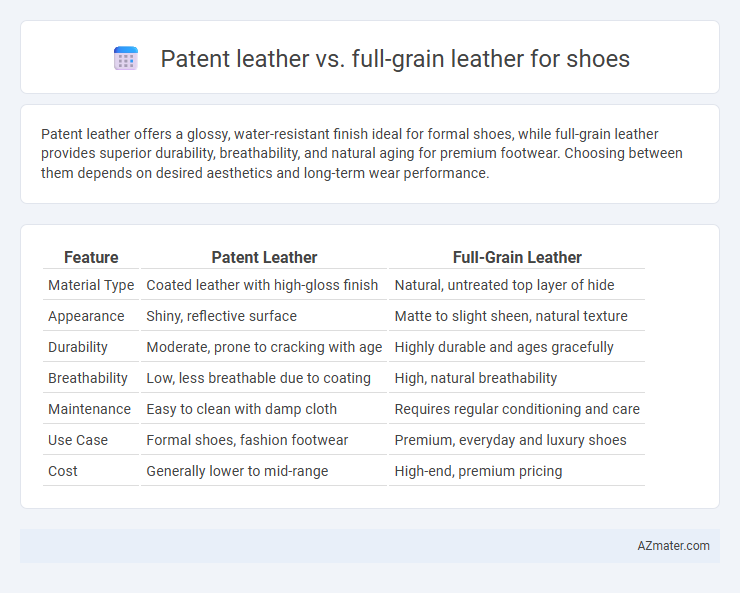Patent leather offers a glossy, water-resistant finish ideal for formal shoes, while full-grain leather provides superior durability, breathability, and natural aging for premium footwear. Choosing between them depends on desired aesthetics and long-term wear performance.
Table of Comparison
| Feature | Patent Leather | Full-Grain Leather |
|---|---|---|
| Material Type | Coated leather with high-gloss finish | Natural, untreated top layer of hide |
| Appearance | Shiny, reflective surface | Matte to slight sheen, natural texture |
| Durability | Moderate, prone to cracking with age | Highly durable and ages gracefully |
| Breathability | Low, less breathable due to coating | High, natural breathability |
| Maintenance | Easy to clean with damp cloth | Requires regular conditioning and care |
| Use Case | Formal shoes, fashion footwear | Premium, everyday and luxury shoes |
| Cost | Generally lower to mid-range | High-end, premium pricing |
Introduction to Patent Leather and Full-Grain Leather
Patent leather is a type of coated leather known for its high-gloss, shiny finish achieved through a lacquer or plastic coating, making it highly resistant to water and stains. Full-grain leather, on the other hand, is crafted from the top layer of the hide, retaining its natural texture and durability, which allows it to develop a rich patina over time. Both materials offer distinct aesthetic and functional qualities in shoe manufacturing, with patent leather favored for formal wear and full-grain leather prized for its longevity and breathability.
Defining Patent Leather: Features and Origins
Patent leather is characterized by its glossy, mirror-like finish achieved through a coating process involving lacquer or plastic, making it highly water-resistant and easy to clean. Originating in the early 19th century, patent leather was invented by Seth Boyden in the United States as a cost-effective alternative to traditional leather finishes. This material is commonly used for formal footwear, where its distinctive shine and smooth texture provide a sleek, polished appearance.
Full-Grain Leather Explained: Structure and Benefits
Full-grain leather is made from the top layer of the hide, retaining its natural grain and pores, which enhances durability and breathability compared to patent leather's synthetic finish. This type of leather develops a rich patina over time, improving aesthetics and softness with wear, unlike the rigid, glossy surface of patent leather. Full-grain leather shoes offer superior comfort, moisture absorption, and longevity, making them a preferred choice for high-quality footwear.
Visual Appeal: Gloss vs. Natural Texture
Patent leather showcases a high-gloss finish that creates a sleek, mirror-like surface ideal for formal footwear. Full-grain leather retains its natural texture and grain, offering a rich, organic appearance that develops character and depth over time. The choice between them depends on whether a shiny, polished look or a timeless, textured aesthetic is preferred for the shoe design.
Durability and Longevity Comparison
Full-grain leather offers superior durability and longevity due to its natural grain and resistance to wear, making it ideal for long-term shoe use. Patent leather, while visually striking with its glossy finish, is more prone to cracking and scuffing over time, reducing its lifespan. Shoes crafted from full-grain leather maintain structural integrity and develop a desirable patina, enhancing their aesthetic appeal even after extensive use.
Comfort and Breathability Differences
Patent leather offers a glossy, durable finish but is less breathable and can cause feet to sweat during prolonged wear. Full-grain leather maintains natural pores, enhancing breathability and providing superior comfort by allowing better air circulation and moisture absorption. For comfort and breathability in shoes, full-grain leather is the preferred choice due to its natural ability to conform to the foot and regulate temperature.
Maintenance and Care Requirements
Patent leather requires regular wiping with a damp cloth and occasional use of a specialized patent leather cleaner to maintain its glossy finish, while avoiding scratches to preserve its shiny surface. Full-grain leather demands more intensive care, including periodic conditioning with leather oils or creams to prevent dryness and cracking, and cleaning with gentle leather cleaners to retain its natural texture and durability. Both materials benefit from storing shoes in a cool, dry place and using shoe trees to maintain shape, but full-grain leather is more susceptible to water damage and requires prompt drying and waterproofing treatments.
Cost and Value Considerations
Patent leather shoes typically cost less than full-grain leather due to their synthetic coating and mass production processes, offering a glossy finish that is more affordable but less durable. Full-grain leather shoes command higher prices reflecting superior quality, natural breathability, and increased longevity, making them a better long-term investment despite the initial expense. Cost-conscious buyers seeking value should weigh the lower upfront price of patent leather against full-grain leather's enhanced durability and comfort over time.
Best Uses: Formal vs. Everyday Wear
Patent leather offers a glossy, polished finish ideal for formal occasions such as weddings, black-tie events, and business meetings due to its sleek and eye-catching appearance. Full-grain leather provides durability, breathability, and natural texture, making it suitable for everyday wear, casual settings, and long-term comfort. The choice between patent leather and full-grain leather hinges on the need for style versus practicality, with the former excelling in elegance and the latter in versatility and resilience.
Choosing the Right Leather for Your Shoes
Patent leather offers a glossy, polished finish that is ideal for formal occasions and easy maintenance, while full-grain leather provides superior durability, breathability, and develops a rich patina over time, making it perfect for everyday wear. When choosing the right leather for your shoes, consider the balance between style needs and long-term comfort, as patent leather focuses on aesthetics and shine, whereas full-grain leather emphasizes practicality and longevity. Opt for full-grain leather if you prioritize resilience and natural aging, but select patent leather for a high-gloss, sleek appearance suited to dress shoes.

Infographic: Patent leather vs Full-grain leather for Shoe
 azmater.com
azmater.com